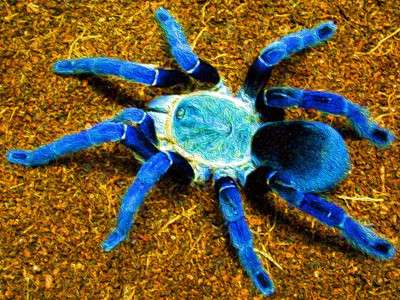
A type of tarantula native to Brazil called the Brazilian white knee tarantula (Acanthoscurria geniculata) is frequently maintained as a pet.
A bird spider with amazing beauty, Geniculata is renowned for its magnificent colors and aggressive behavior. This animal grows quite quickly as well; in less than two to three years, it can reach a leg-span of eight to nine inches.
Body Appearance
- The Brazilian whiteknee tarantula’s body and legs are both a dark shade of black, yet on rare occasions, the legs could be a little bit lighter.
- The stark white bands on its legs, which are typically thought to be the primary factor in determining its subjective beauty, contrast with this.
- Males are less colorful and smaller in size. This species of tarantula is larger than others, having a body length of up to 9 centimeters (3.5 in).
- These grow quickly; it typically takes them 3–4 years to achieve an adult leg span of 8.5 inches for females.
Regional distribution
The Rio Branco region of Brazil is the natural home of the Brazilian Whiteknee.
Habitat
The Brazilian Whiteknee prefers to live in the warm, tropical Brazilian jungles, as implied by its name. The range of their ideal temperature is between 23 and 29 degrees Celsius. They would start looking for refuge immediately as the temperature reached the limit of what they could tolerate (more than 30 degrees Celsius), such as under huge tree trunks, holes in branches and cracks in rocks.

Diet
They thrive on a diet of locusts, small lizards, big insects, and small rodents in their natural environments (like mice).
Reproduction
While many other Brazilian tarantulas have a more difficult time mating, the female Brazilian Whiteknee tends to be very protective and docile with the males. Ideally, you should begin mating them 4-6 weeks after the tarantula has shed its skin. Make certain the woman is not overweight when she first encounters the man. Finally, use tweezers to separate them once they have mated.
They can then get ready for the cocooning process thanks to this. Reduce the humidity during the day and raise it at night for the first three months after mating. The female will instantly begin to form a cocoon as a result. Around 4-7 months after mating, the normal female begins to make her cocoon. A cocoon will hold between 600 and 1000 eggs.
Pet
These tarantulas have been highly sought after as pets because of their size, toughness, and eye-catching colors. Like most other tarantulas found in the Americas, they are often somewhat protective and their urticating’s hairs can be highly unpleasant to human skin.
Like many undomesticated pets, these spiders have the ability to bite when threatened. However, they rarely use biting as a primary line of defense because of their urticating’s hairs. Despite the fact that their venom is not thought to have any significant medical effects, their size allows them to destroy machinery.
Table





